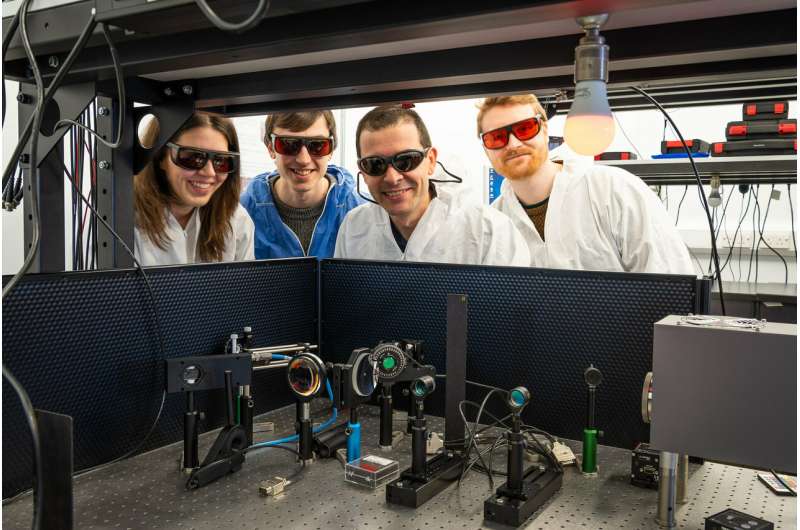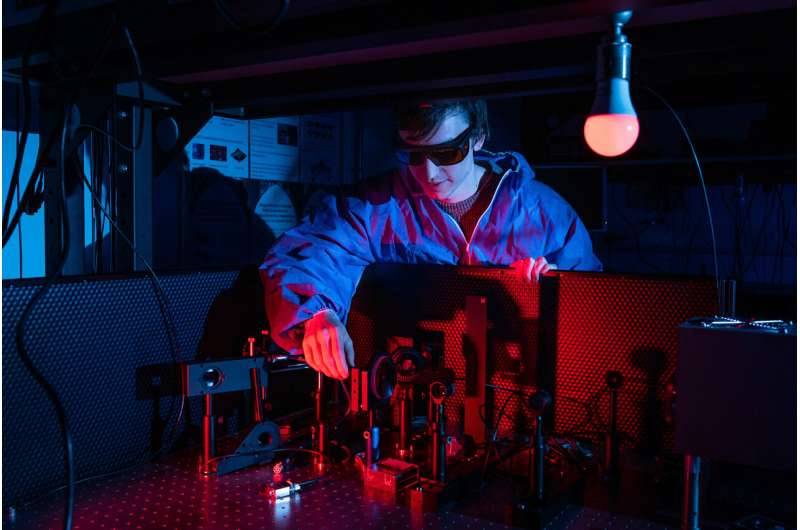New physical effect demonstrated after 40 year search

A new physical effect has been demonstrated at the University of Bath after 40 years of pursuit by physicists around the world, which could lead to advancements in chemical manufacturing efficiency, miniaturisation and quality control in personalised pharmaceuticals.
For the first time ever the research team in the Department of Physics was able to use a physical effect—specifically the colour-changing of light scattered from chiral molecules—to measure the chirality present, confirming predictions of theoretical work from the 1970s.
The technique is 100,000 times more sensitive than standard methods used today.
Chirality describes the orientation of molecules, which can exist in left or right 'handed' forms depending on how they twist in three dimensions. Many molecules essential to life, including DNA, amino acids and proteins, exhibit chirality and the handedness can totally change their function or properties. Therefore knowing the chirality of a substance is often critically important.
For decades scientists had sought to prove that you could accurately determine the chirality of molecules by measuring a colour-changing (nonlinear) effect upon illumination with twisted (circularly polarised) light. In theory, twisted light could change colour and then scatter differently from differently handed molecules—but this had never been demonstrated experimentally.
Dr. Ventsislav Valev, who leads the research group in the Department of Physics at the University of Bath, said: "We've demonstrated a new physical effect—you don't get to say that every day. This is exactly why I got into science.
"We began thinking about the problem 13 years ago, together with Prof Thierry Verbiest, at KU Leuven, Belgium. Because the effect was so elusive, I knew half of the solution would be to develop a very sensitive experimental setup. This is what I did for many years. The other half was finding the right samples and I was really excited to discover the nanoscopic silver springs (nano-helices) fabricated by Prof Peer Fischer's group, at the Max Planck Institute for Intelligent Systems, in Stuttgart, Germany."
Ph.D. student Joel Collins had an incredible moment when running a series of tests on these springs.
He said: "To be honest my attitude was almost 'OK let's get this out the way to make sure it doesn't work and we can move onto something else'. Then, together with my colleague Dr. Kristina Rusimova, we noticed that there did actually seem to be an effect, and I thought 'Hmmmm, that's interesting.'
"We kept repeating the experiment to make sure it was actually a real effect and we saw that not only it's there but it's huge—we were only using really low concentrations of our nano-helices.
"For my part, I didn't really recognise how important it is, and was expecting someone to come along and rip it to shreds, to say - 'you haven't thought of that' or 'you've missed this'. But over time it has dawned on me—that this is actually a fantastic result."

The experimental geometry is in fact quite simple; the nano-springs are dispersed in water within a glass container where they spread randomly. Then a laser is aimed at them. The twist (circular polarisation) of the laser is switched periodically and light scattered from the container at 90° is analysed to determine the chirality of the springs present. The research is published in Physical Review X.
Dr. Valev added: "It's taken 40 years, people have been looking for this without success, and not for lack of trying. It's amazing. The theory was quite controversial, people thought that maybe the effect was impossible to observe, maybe something else was there, blocking it.
"For 200 years, scientists have been using the same method to measure chirality. It's not very sensitive, but it's robust and simple, however precise measurements of chirality have become a major hurdle for human-made chiral nanotechnology because of false positives.
"Now we have a method 100,000 times more sensitive, free from false positives. There's a new kind of manufacturing process currently emerging. It is called 'lab-on-a-chip' and our effect fits very well with it.
"A more sensitive test means you can use lower quantities in quality control and reduce waste, there are applications in chemical and pharmaceutical manufacturing, as well as in microfluidics, in miniaturisation and for developing personal pharmaceutical technologies."
Advanced laser sources, sensitive detection equipment and state-of-the-art nanofabrication techniques have all come together to enable the experimental observation of the new effect.
Professor David Andrews, from the University of East Anglia, theorised the effect 40 years ago. He said: "Dr. Valev's pioneering work is a clever and highly significant achievement, for he has realised a kind of application that could never have been imagined when the theory was first laid, forty years ago.
"His results serve as an encouragement to all pure theorists!"
Next, the researchers will be using their findings to characterise chiral molecules and to develop its technological applications.
The paper "First observation of optical activity in hyper-Rayleigh scattering" is published in Physical Review X.
More information: "First observation of optical activity in hyper-Rayleigh scattering", Physical Review X (2019). DOI: 10.1103/PhysRevX.9.011024
Journal information: Physical Review X
Provided by University of Bath




















